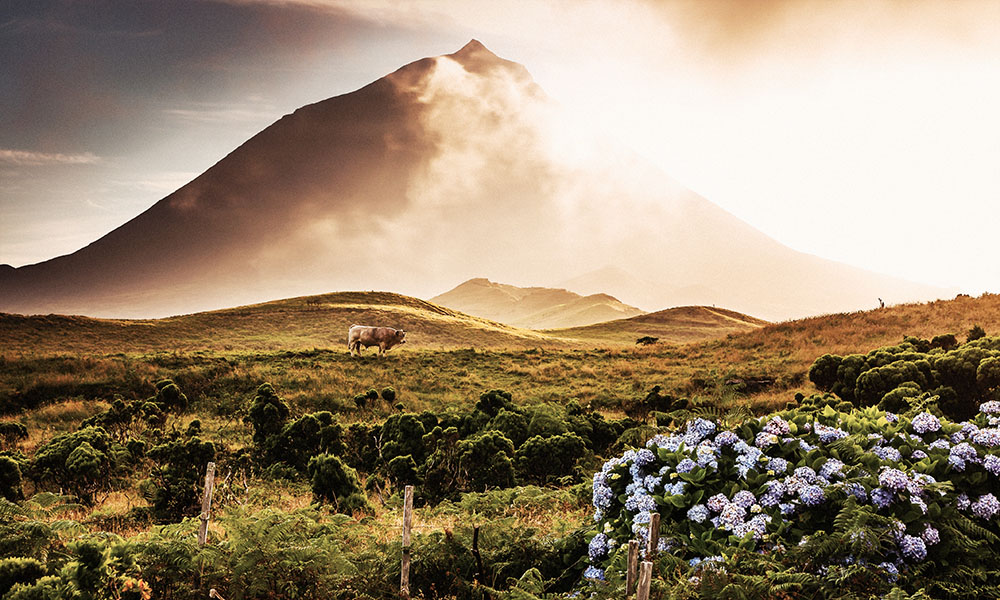It was after midnight — well after midnight — and the river of wine that had sluiced through the course of dinner had dried to a bare trickle, giving way to more potent potables. On hand was a typically Azorean feast of pork ribs, chouriço and morcela sausages, fried cornbread, roast chicken and the famous São Jorge cheese, made ever more delicious with cup after cup of rustic red wine and followed by the usual plethora of pastries. The mood in the packed room was festive, and though no holiday or other significant date was being observed, it was a celebration nonetheless. A celebration of food, friends, wine, song and life in general. We toasted into the morning with liberal doses of potent aguardente — the indigenous moonshine that seemingly everyone, with great pride home-distills and which is deceptively easy to drink way too much of.
I dubbed the Centro Civico da Relva (the site of the previous night’s adventure — essentially the town hall) “The House of Pain.” Not that there was anything painful about the ultra-affordable and delicious meals it regularly hosts, it’s just that aguardente, when consumed in bulk, can make the following morning a bit, well, slow.
Relva, a 12-square-kilometre civil parish, lies just west of Ponta Delgada, the largest municipality and capital city of São Miguel — itself the largest of the nine islands that make up the Azores archipelago. Technically part of Portugal, the volcanic Azores bob in the North Atlantic, about a five-hour flight from Toronto and a two-hour one from the Portuguese mainland. Officially the Região Autónoma dos Açores, its inhabitants don’t really equate themselves with their mainland brethren, choosing instead to remain independent-minded and culturally distinct.
Though the “evening” at the Centro Civico wrapped up very late, the day had begun considerably earlier. With wine, beer, food, and other essentials (like aguardente … groan) firmly secured on the back of our trusty burro, Pasqual, we trekked slowly down a sheer oceanside cliff leading to a summer house in the area of Rocha da Relva. The lodging had been in the hands of my friend Nelia’s family for generations (she was born on the island). Nelia and her hubby, Taras, visit the island regularly. I was fortunate enough to be invited on their most recent jaunt to live the Azores life in a decidedly non-touristy manner.
As we moved ever closer to the rocky coastline below, I took in the slightly surreal surroundings. Seemingly ancient stone homes appeared to grow out of the steep incline, their chimneys wafting fragrant wood smoke. Somewhat fittingly, Madonna’s “La Isla Bonita” also wafted out of the open window of one home. A lone skin diver, sheathed in black neoprene, patrolled the dark waters past the breakers like a territorial sea lion. Seabirds wheeled as the morning sun glinted off the rippling grey surf. Fruit and vegetable gardens flourished in precariously terraced plots that, defying gravity, clung to the steeply angled slope.
Pasqual seemed not to share my wonderment. He’d done this route more times than he probably cared to remember so was trudging ahead with the stoic/stubborn indifference that only an overburdened beast of burden could muster.
The day was spent relaxing by the ocean, enjoying libations and a lunch of grilled chicken, pork and various sausages expertly prepared by Nelia’s Uncle Humberto. As the sun began to dip, we loaded up Pasqual and began a somewhat weary ascent up the cliffside, pausing every once and a while to massage aching legs and catch a breath, the anticipation of the evening ahead at the Centro Civico with Nelia’s extended family and Relva locals keeping us fuelled.

